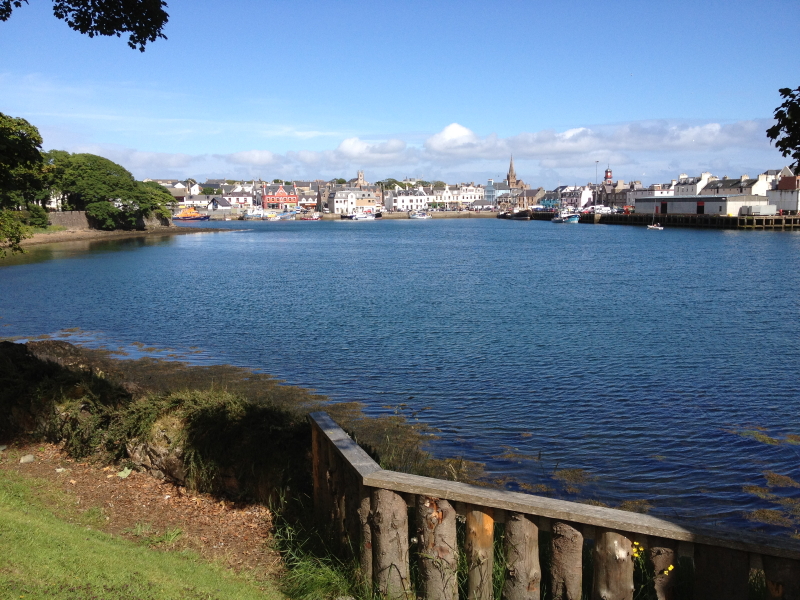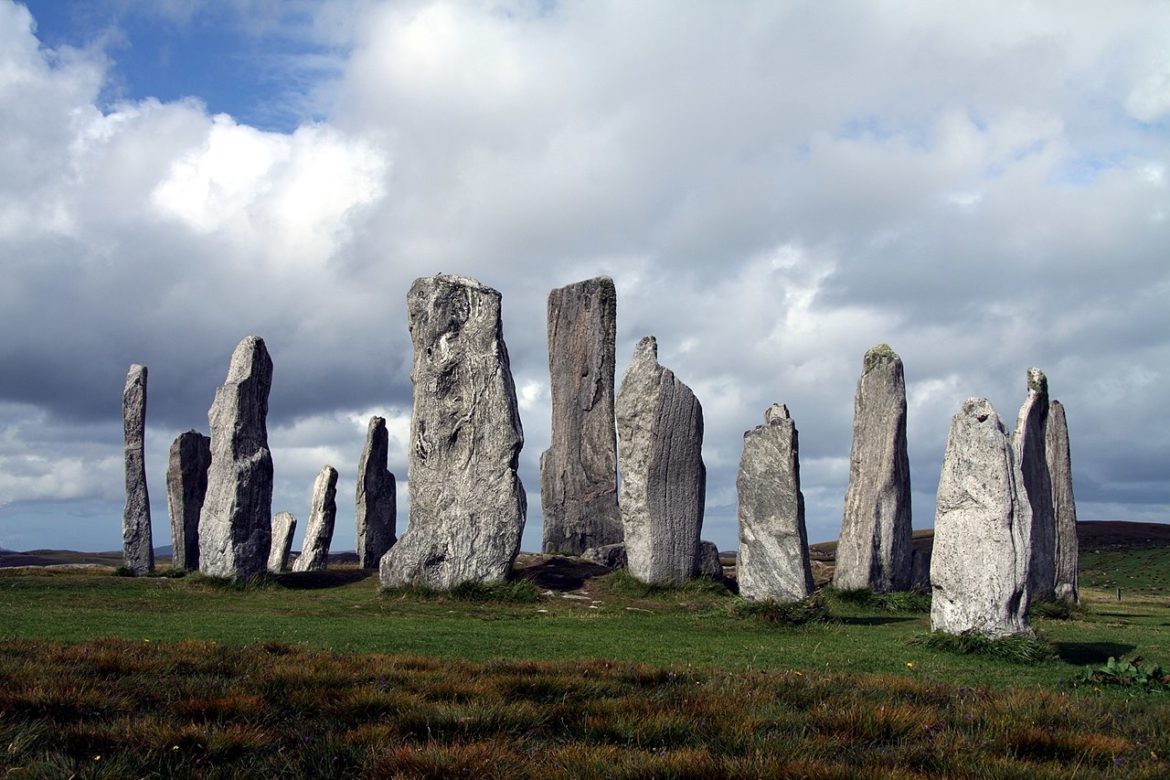STORNOWAY, Scotland – Archaeologists have made a fascinating discovery at the ancient standing stone circle of Callanish, close to Stornoway on the island of Lewis in the Western Isles of Scotland. The stone circle is well known to British and Irish Pagans and has featured in esoteric fiction such as the ‘Adept’ series by Katherine Kurtz and Deborah Turner Harris. Recently a geophysical survey around the stones has revealed a star-shaped pattern deep in the peat beneath the circle: evidence of an ancient lightning strike. The find has given rise to speculation that the stone circle was possibly built in response to this meteorological event.
Callanish (Gaelic ‘Calanais’) was constructed some 5000 years ago from Lewisian gneiss, in the region of 500 years before Stonehenge. The main stone complex consists of about 50 stones in the shape of a cross. The inner circle is composed of 13 stones, plus a small chambered cairn, which seems to have pre-dated the main site. There are other circles and stones near the main site itself. Callanish was abandoned around a thousand years after it was built, and then became embedded in peat, which gradually accumulated high around the stones. It was excavated in 1857 and subsequently, some of the stones were damaged.

Stornoway, Isle of Lewis. [Photo Credit: Lorna M. Campbell CC BY-SA 4.0]
The site seems to have astronomical associations, which have been somewhat controversial. Surveyor Boyle Somerville suggested in 1913 that the northern avenue was linked to the rising of the star Capella about 1800BC. He also connected the west row of the stones with the setting sun at the two equinoxes and suggested that a line between the two individual stones outside the circle indicated the rise of the moon at its maximum (major standstill). However, researchers from the University of Adelaide have also recently established lunar links with the stone circle. Dr. Gail Higginbottom says of the research overall, which concentrated on a number of stone circles throughout Britain:
“These chosen surroundings would have influenced the way the Sun and Moon were seen, particularly in the timing of their rising and setting at special times, like when the Moon appears at its most northerly position on the horizon, which only happens every 18.6 years. For example, at 50 percent of the sites, the northern horizon is relatively higher and closer than the southern and the summer solstice Sun rises out of the highest peak in the north. At the other 50 percent of sites, the southern horizon is higher and closer than the northern, with the winter solstice Sun rising out of these highest horizons. These people chose to erect these great stones very precisely within the landscape and in relation to the astronomy they knew. They invested a tremendous amount of effort and work to do so. It tells us about their strong connection with their environment, and how important it must have been to them, for their culture and for their culture’s survival.”
With relation to Callanish itself, the researchers found a concentration of alignments towards the sun and moon at different times of their cycles. Callanish expert, Patrick Ashmore, suggests that “every 18.6 years, the moon skims low over the southern hills. It seems to dance along them, like a great god visiting the earth. Knowledge and prediction of this heavenly event gave earthly authority to those who watched the skies.”
The climate would have been milder in late Neolithic times than it is today, and the sea level would have been lower, so the landscape itself would not appear quite as it does today.

Callanish Stones near Callanish village, Isle of Lewis, Outer Hebrids, Scotland [Photo Credit: Chmee CC BY-SA 3.0]
Local legend speaks of a ‘shining one’ who walks down the main avenue at midsummer and it was customary for local people to visit the stones at the beginning of May although the church disapproved. Callanish has no astronomical connections with Beltane, so this practice would have come later, but folklore does not remain static down the years. One legend tells us that the stones represent giants who refused to be converted to Christianity by St Kieran.
However, the revelation of the lightning strike brings some new mysteries to this ancient site. The strike pattern is found by one of the individual stones: the 1.5-metre-high stone, at the site of Airigh na Beinne Bige, was originally part of another circle and the lightning strike pattern appears at its centre.
Vincent Gaffney, one of the researchers who made this new discovery, says
“We’re really excited. This was completely and utterly unexpected. Seeing the evidence for a massive strike, right in the middle of what now seems to be a stone circle, is remarkable.”
The strike itself, shown by the presence of magnetized earth revealed by remote sensing techniques, pre-dates the formation of the peat and thus also probably pre-dates the stone circle itself, although this is not absolutely certain. Gaffney adds
“We’ve never seen this before. It just says so much about how our ancestors related to nature. It is not a great leap of the imagination to believe early societies would have been enamored with natural events. Standing stones are linked, for instance, to astronomic events. Remember what Jove used as a weapon – lightning bolts. This is something which occurs in a number of religions. So we can identify here a rule of nature perhaps informing or reinforcing belief structures in the past. The prospect of understanding why a particular stone circle might be in a particular location is amazing. We’re always trying to get into other people’s heads when we’re thinking of these ancient ritual sites. Well, we might now have an idea.”
The possibility that the circle was erected in some kind of commemoration of a massive lightning strike does not negate earlier theories relating to astronomical alignment. The stones could have been erected in relation to lunar cycles, on the earthly site of the strike, and there is still a possibility that the strike might have occurred later, once the stones themselves were already in place. How these different phenomena were seen to be connected by the circle builders must remain a matter for speculation.
The Wild Hunt is not responsible for links to external content.
To join a conversation on this post:
Visit our The Wild Hunt subreddit! Point your favorite browser to https://www.reddit.com/r/The_Wild_Hunt_News/, then click “JOIN”. Make sure to click the bell, too, to be notified of new articles posted to our subreddit.
